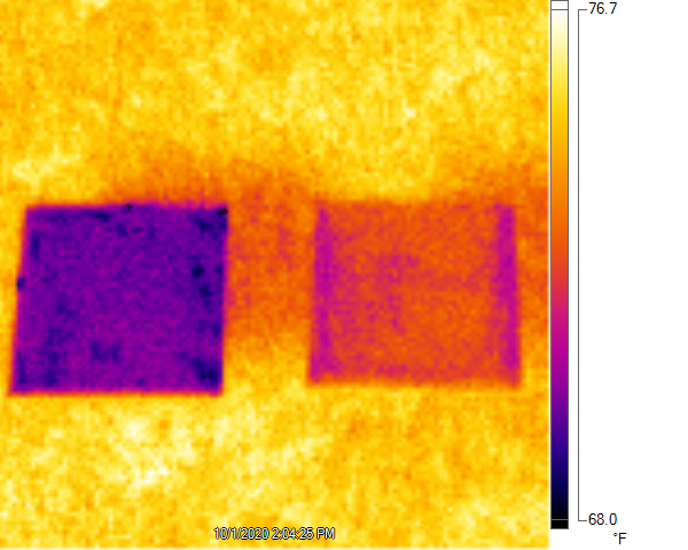New White Paint on Roofs Could Generate 'Free Air Conditioning'
Researchers Develop White Paint that Sends Heat into Deep Space

Purdue researchers Xiulin Ruan and Joseph Peoples use an infrared camera to compare the cooling performance of white paint samples on a rooftop. Photo: Purdue University photo/Jared Pike.

An infrared camera image shows that white radiative cooling paint developed by Purdue University researchers (left, purple) can stay cooler in direct sunlight compared with commercial white paint. Image: Purdue University image/Joseph Peoples.


WEST LAFAYETTE, Ind. — A new white paint that could reduce the need for air conditioning may find its way into the hands of roofing contractors.
Developed by engineers at Purdue University, the acrylic white paint maintains a lower temperature under direct sunlight than other commercial white paints, keeping surfaces up to 18 degrees Fahrenheit cooler than their ambient surroundings. With no heat buildup, researchers say there’s no need for air conditioners to turn on.
“It’s very counterintuitive for a surface in direct sunlight to be cooler than the temperature your local weather station reports for that area, but we’ve shown this to be possible,” said Xiulin Ruan, a Purdue professor of mechanical engineering.
In a paper published in the Cell Reports Physical Science journal, researchers state the white paint has a high solar reflectance of 95.5%, performing better than solar reflectance roofing materials tested at the Lawrence Berkeley National Laboratory. The paint is so efficient that it sends heat into deep space, where it travels indefinitely at the speed of light. By sending it away from Earth, the paint can help reduce global warming.
“We’re not moving heat from the surface to the atmosphere. We’re just dumping it all out into the universe, which is an infinite heat sink,” said Xiangyu Li, a postdoctoral researcher at the Massachusetts Institute of Technology who worked on this project as a doctorate student in Ruan’s lab.
When developing the paint, one of the first applications researchers considered was roofs. When applied to the roof of an average 1,076 square-foot ranch home, researchers estimate the paint would save homeowners $1 a day that would’ve otherwise been spent on air conditioning.
“Your air conditioning kicks on mainly due to sunlight heating up the roof and walls and making the inside of your house feel warmer,” said Joseph Peoples, a Purdue doctorate student in mechanical engineering and a co-author of the work. “This paint is basically creating free air conditioning by reflecting that sunlight and offsetting those heat gains from inside your house.”
Creating the paint was no easy feat. The six-year study picks up on attempts going back to the 1970s to develop a radiative cooling paint as an alternative to air conditioners. After testing more than 100 different combinations, the researchers settled on a formula made of calcium carbonate, an abundant compound found in rocks and seashells.
Thanks to this formula, researchers estimated the paint would be cheaper to produce than commercial alternatives, meaning it would cost similar to current commercial paints. Researchers are already working on developing other paint colors with cooling benefits and filed an international patent application on the formulation.
Will White Work?
It’s too soon to tell whether the paint will one day cover every major rooftop in urban areas and the homes of energy-savvy consumers. After all, roofing experts agree that white isn’t always right, as a roof system’s success depends on all of its components working together, not just the color. Researchers are also in the midst of a long-term reliability test to determine the paint’s longevity against factors like UV exposure, dust, and water resistance. If it isn’t shown to be durable, it could clash with the growing desire among consumers for longer-lasting roofs.
Additionally, solar systems on roofs can provide cooling effects while simultaneously generating clean energy; however, those looking to save on energy bills may consider the cheaper option of a coat of paint instead of the upfront costs of a solar installation.
“Our radiative cooling paint showed a cooling performance that was among the best of the reported state-of-the-art approaches, while offering unprecedented combined benefits, including convenient paint form, low cost, and compatibility with commercial paint fabrication processes,” the researchers’ paper states.
Looking for a reprint of this article?
From high-res PDFs to custom plaques, order your copy today!








